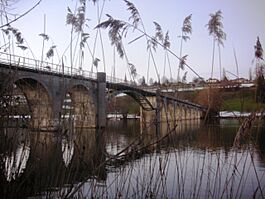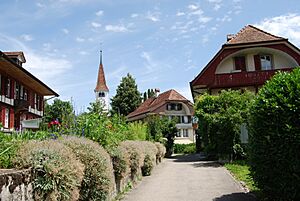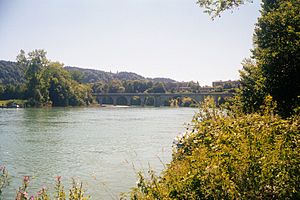Frauenkappelen facts for kids
Quick facts for kids
Frauenkappelen
|
|
|---|---|
 |
|
| Country | Switzerland |
| Canton | Bern |
| District | Bern-Mittelland |
| Area | |
| • Total | 9.29 km2 (3.59 sq mi) |
| Elevation | 601 m (1,972 ft) |
| Population
(Dec 2020 )
|
|
| • Total | 1,320 |
| • Density | 142.1/km2 (368.0/sq mi) |
| Postal code |
3202
|
| Surrounded by | Bern, Mühleberg, Wohlen bei Bern |
Frauenkappelen is a small town, also called a municipality, in Switzerland. It's located in the Bern-Mittelland area, which is part of the Bern canton. Think of a canton like a state or a large region within Switzerland.
Contents
History of Frauenkappelen
Frauenkappelen was first written about in 1158. Back then, it was called Capela. In 1574, the town became a parish, which means it had its own main church and area it served.
The oldest signs of people living here are ancient grave mounds from the Hallstatt culture in the Spilwald forest. This culture existed in Europe during the late Bronze Age and early Iron Age. People also found an old Roman-era farm in the woods. It seems the area was empty for a while after the Romans left, until the Early Middle Ages.
Around 1241, a castle called Alt-Bubenberg Castle was built on the hills near the Aare river. Between 1228 and 1240, a special religious building, the Augustinian Sancta Maria de Cappellis Abbey, was built. An abbey is like a monastery for nuns. Over time, the Alt-Bubenberg Castle became less important and was left empty in the 1300s. Today, you can only see parts of its old walls.
The Abbey, however, grew bigger because rich people gave it land and money. By the 1300s, it owned land in many places, even vineyards near Lake Biel. The Abbey had its own official seal in 1251. About ten nuns lived there, led by an Abbess, and a provost (a type of priest) from another Abbey helped them.
Later, the Teutonic Knights, a famous group of knights, took over the Abbey. In 1486, the main church in Bern, the Bern Minster, took control of the Abbey and its lands. The six nuns still living there were allowed to stay for the rest of their lives. The Abbey church was rebuilt in 1574 and became the main church for the new Frauenkappelen parish. The old Abbey buildings were used as a rectory (a home for the priest) until they were taken down in 1640.
In the 1700s, a new road was built from Murten to Bern and Lausanne. Frauenkappelen became the first stop outside Bern on this road. An inn (like a hotel), a blacksmith, a general store, and a place for travelers to stay were built. However, Frauenkappelen stayed mostly a farming community until the 1960s. Then, as the city of Bern grew, more factories and people who worked in the city moved to Frauenkappelen. Today, it's still a mostly rural town, but it's close to the bigger city of Bern.
Geography of Frauenkappelen
Frauenkappelen covers an area of about 9.3 square kilometers (about 3.6 square miles). A large part of the land, about 42.3%, is used for farming. Forests cover about 41.1% of the area. Buildings and roads take up about 6.8% of the land. Rivers or lakes make up 9.3%, and a small part (0.8%) is land that can't be used for anything.
Most of the forested land is covered with thick forests. For farming, about 28.6% of the land is used for growing crops. Another 12.3% is used for pastures where animals graze. A small part, 1.4%, is used for orchards (fruit trees) or vineyards. All the water in the town is in lakes.
Frauenkappelen is located on a flat area between Lake Wohlen and a stream called Gäbelbach. The town includes the main village of Frauenkappelen, plus several smaller villages called hamlets, and scattered individual houses.
In 2010, Frauenkappelen joined a new administrative area called Verwaltungskreis Bern-Mittelland. This changed how the local government was organized.
Frauenkappelen's Coat of Arms
The town's official symbol, its coat of arms, shows a blue background. On it, there are two golden shepherd's staffs (called croziers) crossed over each other. On top of these, there is a silver cross with pointed ends.
People of Frauenkappelen (Demographics)
As of 2011, Frauenkappelen had a population of about 1,246 people. A small part of the population, about 6.9%, are people from other countries who live there. Over the last ten years, the number of people living in Frauenkappelen has slightly decreased. This is mostly because more people moved away than moved in.
Most people in Frauenkappelen (about 94.8%) speak German as their main language. A smaller number speak French (1.5%) or Albanian (0.7%).
In 2008, about 49.7% of the population were male, and 50.3% were female. Most people living in Frauenkappelen were born in Switzerland. About 28% were born right in Frauenkappelen, and 47.7% were born in the same canton (Bern). About 7.5% were born outside of Switzerland.
In 2011, children and teenagers (ages 0-19) made up about 19.2% of the population. Adults (ages 20-64) made up 63.2%, and seniors (over 64) made up 17.6%.
In 2000, about 28% of the people in Frauenkappelen were single and had never been married. Most people were married. There were also some widows, widowers, and divorced individuals.
In 2010, there were 157 homes where only one person lived. There were also 34 homes with five or more people. Most apartments in the town are lived in all the time.
Interesting Sights
The two small villages, or hamlets, called Riedbach and Wolei, are special. They are recognized as important Swiss heritage sites, meaning they have historical or cultural value.
Economy of Frauenkappelen
In 2011, the unemployment rate in Frauenkappelen was very low, at 0.91%. This means almost everyone who wanted a job had one. In 2008, about 500 people worked in the town.
Jobs in Frauenkappelen are divided into three main types:
- Primary sector: This includes jobs related to farming, like growing crops or raising animals. About 74 people worked in this area.
- Secondary sector: These jobs involve making things, like in factories or construction. About 275 people worked in this sector.
- Tertiary sector: This includes jobs that provide services, like working in shops, restaurants, or offices. About 151 people worked in this sector.
Most people who live in Frauenkappelen work outside the town. About 570 people leave Frauenkappelen for work each day, while 277 people come into the town to work. This means more people leave for work than come in. About 26% of workers use public transportation to get to work, and 53.8% use a private car.
Religion in Frauenkappelen
Based on a survey in 2000, most people in Frauenkappelen (about 72.2%) belonged to the Swiss Reformed Church, which is a Protestant church. About 11.4% were Roman Catholic.
A smaller number of people belonged to other Christian churches (like Orthodox or other Protestant groups). About 1.95% of the population were Muslim. A very small number were Buddhist. About 6.09% of the people said they didn't belong to any church or were agnostic (not sure about God) or atheist (don't believe in God).
Education in Frauenkappelen
In Frauenkappelen, about 59% of adults have finished non-mandatory upper secondary education. This means they went to school beyond the basic required years. About 24.5% have gone on to higher education, like a university or a specialized college.
The school system in the Canton of Bern works like this:
- One year of optional Kindergarten.
- Six years of Primary school.
- Three years of required lower Secondary school. Here, students are grouped based on their abilities.
After lower Secondary, students can choose to continue their schooling or start an apprenticeship (learning a trade on the job).
During the 2011-2012 school year, 73 students attended classes in Frauenkappelen. There was one kindergarten class with 14 students. The town also had three primary classes with 59 students. A small number of these students were from other countries or spoke a different language at home.
In 2000, most students (111 out of 114) who went to school in Frauenkappelen also lived there. However, 97 students who lived in Frauenkappelen went to schools outside the town.
See also
 In Spanish: Frauenkappelen para niños
In Spanish: Frauenkappelen para niños







